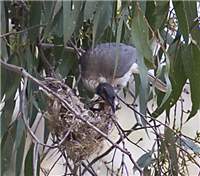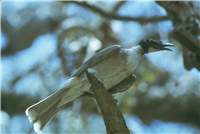Family
Meliphagidae
Genus
Philemon
Species
corniculatus
Threats/Control Methods - Regional
This species has been hunted in the past due to its ability to destroy ripening fruits. It may also be a threat to local woodlands by spreading the seeds of fruit and nectar bearing weeds, such as blackberries.
Threats/Control Methods - Local
Free roaming Cats (Felis catus) may pose a threat to young birds in and around the nest.
Local/Urban Actions
Fruit trees can be protected from these birds by netting or sound and visual deterrents.
Common Names
Noisy Friarbird, Leatherhead, Four-o'clock, Knobbynose, Monk, Pimlico, Poor Soldier
Distinguishing Features
Its naked black head and strong beak with a large bump at the base readily distinguish the Noisy Friarbird from other birds. The plumage is mostly grey-brown on top with light creamy underparts.
Survey Techniques
Call and visual identification.
Species Call
A continuous goose-like honking, or sharp 'owk!-owk!'.
Similar Species
The Red Wattlebird (Anthochaera curunculata) is similarly sized and can look similar in flight, but lacks the square tail, unstreaked belly and distinctive black head.
Distribution
The Noisy Friarbird is found right across the eastern side of the Australian mainland, from far north Queensland to central Victoria. It is also found in southern Papua New Guinea.
Country of Origin
Australia
Conservation (Pet/Pest) Status - Regional
The population numbers are fairly consistent (COG).
Conservation (Pet/Pest) Status - National
Secure, not listed under the EPBC Act 1999. Numbers appear to be decreasing to the west of their range and in the far north.
LSCCES Population
The birds were found in fairly high numbers in Turner, with a few in Civic West and ANU.
Associated vegetation community
The Noisy Friarbird will exist in open forest, woodland, and heath, along river edges in dry regions or mangroves.
Limiting Resources
This species depends upon a good availability of fruiting and nectar-bearing trees. The growing number of local Red Wattlebirds (Anthochaera curunculata) keeps down their numbers in the Canberra region, as they compete for resources.
Breeding
Three eggs are usually laid to a life-long breeding pair. The eggs are oval shaped and coloured pink-brown with lavender spots. Their nest is built on an outer tree branch, made of bark, wool and other fibres, placed from 3-10 metres from the ground. The female incubates eggs for around 18 days. Young are fed by both parents for a further 18 days. In the Canberra region, nest building starts from late September and dependant young are recorded from November to February, and are easily identified by their calling.
Behaviour
Noisy Friarbirds are a common migrant to Canberra over the summer months, spending most of their time up in tall trees feeding on nectar in noisy flocks. They capture flying insects with spectacular manoeuvring skills. They compete with the Red Wattlebird (Anthochaera curunculata) and the two species display aggressive behaviour towards one another. The Friarbird will also display aggression towards humans who are close to their nest.
Functional Group
Food Species
The Noisy Friarbird eats nectar, fruit, insects and other invertebrates and sometimes eggs or baby birds.
Predators
The Common Koel (Eudynamys scolopacea ) may visit the nest of the Noisy Friarbird, pushing out its young. The Friarbird can become a predator itself, known for taking the eggs and young of Common Starlings (Sturnus vulgaris ).
Interesting Fact
Some of the Noisy Friarbird's honks sound like the words 'tobacco' or 'four-o-clock'. Its baldhead may be the reason the species migrates out of Canberra for the winter, as it is not protected against the colder temperatures.
References - (reader suitability of references, P=Primary teachers, S=Secondary students, T=Tertiary students and researchers)
Books:Longmore, W. 1991. Honeyeaters and their Allies of Australia. CollinsAngus&Robertson Publishers Australia. NSW. P, S, T
Morcomber, M. 2000. Field guide to Australian Birds. Steve Parish Publishing, Archerfield. P, S, T
Veerman, P. 2003. Canberra Birds: A report on the first 21 years of the garden bird survey. Philip Veerman and Canberra Ornithologists Group. Canberra. S, T
Internet: Birds in Backyards 2006. [online]. Available at:http://www.birdsinbackyards.net P, S, T
Canberra Ornithological Group (COG). 2004. Birds of Canberra Gardens. COG and the ACT Department of Urban Services. [online]. Available at:http://garden.canberrabirds.org.au/ P, S, T
Reports:Nix, H. and Cunningham, R. 2006. Birds of the Lower Sullivans Creek Catchment, Canberra ACT. Prepared for the Life in the Suburbs project using data from the Lower Sullivans Creek Catchment Ecological Survey (LSCCES). Australian National University. Canberra. [online]. Available at http://www.lifeinthesuburbs.com.au/category.php?id=65 S, T


 Top
Top Top
Top